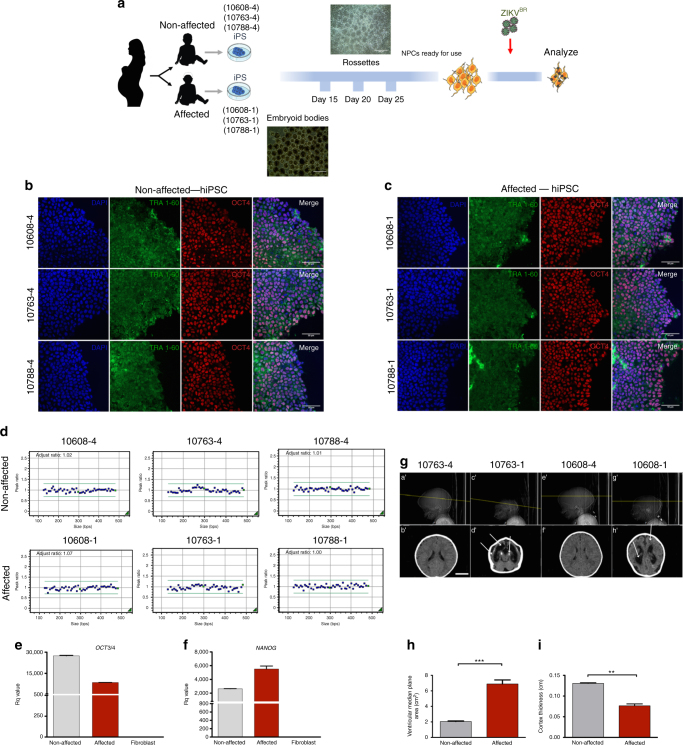Discordant congenital Zika syndrome twins show differential in vitro viral susceptibility of neural progenitor cells.
Congenital Zika syndrome (CZS) causes early brain development impairment by affecting neural progenitor cells (NPCs). Here, we analyze NPCs from three pairs of dizygotic twins discordant for CZS. We compare by RNA-Seq the NPCs derived from CZS-affected and CZS-unaffected twins. Prior to Zika virus (ZIKV) infection the NPCs from CZS babies show a significantly different gene expression signature of mTOR and Wnt pathway regulators, key to a neurodevelopmental program. Following ZIKV in vitro infection, cells from affected individuals have significantly higher ZIKV replication and reduced cell growth. Whole-exome analysis in 18 affected CZS babies as compared to 5 unaffected twins and 609 controls excludes a monogenic model to explain resistance or increased susceptibility to CZS development. Overall, our results indicate that CZS is not a stochastic event and depends on NPC intrinsic susceptibility, possibly related to oligogenic and/or epigenetic mechanisms.
Authors
Luiz Carlos Caires-Júnior; Ernesto Goulart; Uirá Souto Melo; Bruno Henrique Silva Araujo; Lucas Alvizi; Alessandra Soares-Schanoski; Danyllo Felipe de Oliveira; Gerson Shigeru Kobayashi; Karina Griesi-Oliveira; Camila Manso Musso; Murilo Sena Amaral; Lucas Ferreira daSilva; Renato Mancini Astray; Sandra Fernanda Suárez-Patiño; Daniella Cristina Ventini; Sérgio Gomes da Silva; Guilherme Lopes Yamamoto; Suzana Ezquina; Michel Satya Naslavsky; Kayque Alves Telles-Silva; Karina Weinmann; Vanessa van der Linden; Helio van der Linden; João Ricardo Mendes de Oliveira; Nivia Maria Rodrigues Arrais; Adriana Melo; Thalita Figueiredo; Silvana Santos; Joanna Goes Castro Meira; Saulo Duarte Passos; Roque Pacheco de Almeida; Ana Jovina Barreto Bispo; Esper Abrão Cavalheiro; Jorge Kalil; Edécio Cunha-Neto; Helder Nakaya; Robert Andreata-Santos; Luis Carlos de Souza Ferreira; Sergio Verjovski-Almeida; Paulo Lee Ho; Maria Rita Passos-Bueno; Mayana Zatz
External link
Publication Year
Publication Journal
Associeted Project
Systems Immunology of Human Diseases
Lista de serviços
-
StructRNAfinder: an automated pipeline and web server for RNA families prediction.StructRNAfinder: an automated pipeline and web server for RNA families prediction.
-
CEMiTool: a Bioconductor package for performing comprehensive modular co-expression analyses.CEMiTool: a Bioconductor package for performing comprehensive modular co-expression analyses.
-
webCEMiTool: Co-expression Modular Analysis Made Easy.webCEMiTool: Co-expression Modular Analysis Made Easy.
-
Assessing the Impact of Sample Heterogeneity on Transcriptome Analysis of Human Diseases Using MDP Webtool.Assessing the Impact of Sample Heterogeneity on Transcriptome Analysis of Human Diseases Using MDP Webtool.
-
Predicting RNA Families in Nucleotide Sequences Using StructRNAfinder.Predicting RNA Families in Nucleotide Sequences Using StructRNAfinder.
-
OUTBREAK: a user-friendly georeferencing online tool for disease surveillance.OUTBREAK: a user-friendly georeferencing online tool for disease surveillance.
-
Noninvasive prenatal paternity determination using microhaplotypes: a pilot study.Noninvasive prenatal paternity determination using microhaplotypes: a pilot study.
-
Editorial: User-Friendly Tools Applied to Genetics or Systems Biology.Editorial: User-Friendly Tools Applied to Genetics or Systems Biology.
-
Automatic detection of the parasite Trypanosoma cruzi in blood smears using a machine learning approach applied to mobile phone imagesAutomatic detection of the parasite Trypanosoma cruzi in blood smears using a machine learning approach applied to mobile phone images
-
Tucuxi-BLAST: Enabling fast and accurate record linkage of large-scale health-related administrative databases through a DNA-encoded approachTucuxi-BLAST: Enabling fast and accurate record linkage of large-scale health-related administrative databases through a DNA-encoded approach
-
Ten quick tips for harnessing the power of ChatGPT in computational biologyTen quick tips for harnessing the power of ChatGPT in computational biology

